The homework for the April City and Guilds class was unusual and experimental Fair Isle. I am trying to be a bit more experimental with my samples but am not sure I am really succeeding. I find it quite hard not to have a little voice at the back of my head thinking about whether it would make a good garment or a practical something-or-other, whereas for these samples the whole point is to experiment and view the sample as art rather than as something necessarily useful.
The first two samples are corrugated Fair Isle. Here you pull the strands across the back of the work tighter than usual to create a raised surface. It is rather hard on the hands! This stitch is often used in tea cosy patterns. The first sample uses the same number of stitches in each colour.
And the second uses more stitches in the purple sections. The other yarn is actually a plastic sandwich bag I cut into a long strip. Not very pleasant to knit with! It feels very stiff and crunchy once knitted up too.
Next I had a go at fulling a bit of Fair Isle. The background yarn is wool while the foreground is cotton. Here is how it looked before.
And here after going through a nice hot wash. I like how the cotton stands out a bit from the fulled fabric as well as the stitches being still well-defined. I didn’t full this until the background stitches were completely obliterated, but it would be interesting to try that too some time.
Next I tried Meg Swansen’s Purl When You Can. This involved purling the stitch if the stitch you are working into is in the same colour, and knitting it if you are changing colour. It creates a fabric which doesn’t curl and can be used around the bottom of jumpers and sleeves to create a non-rolling edge without interrupting the pattern. The first sample I purled when I could in both the background and foreground colours.
For the second sample I only purled when I could in the background colour, and worked the foreground colour in knit. This is enough to stop it curling, and doesn’t disrupt the pattern as much.
Both of these seeemed to work well when there were strong diagonal lines in the pattern, but some more delicate details were rather lost.
For my last sample I worked a Fair Isle pattern using two different weights of yarn. The background is aran weight, and the foreground 4ply weight.
I’m not sure that this one was a great success. Fair Isle is actually very forgiving of different weights of yarn, and although the background does show through the foreground a bit, it is not nearly as obvious as I thought it would be.
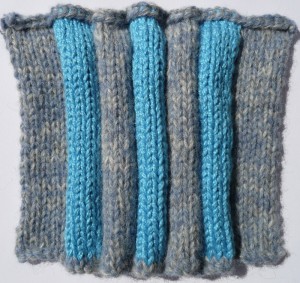
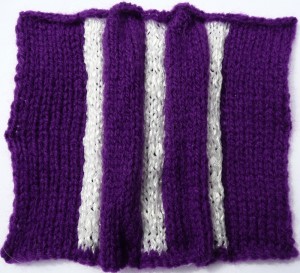
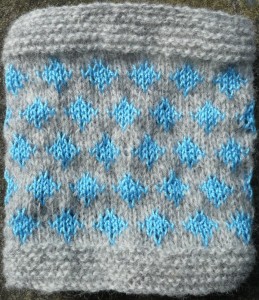
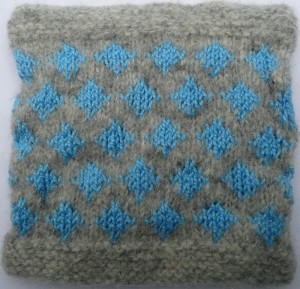
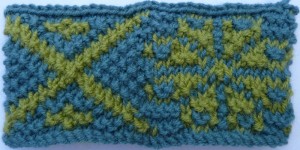
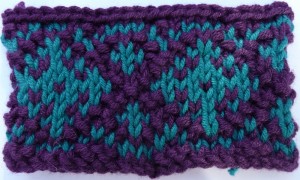
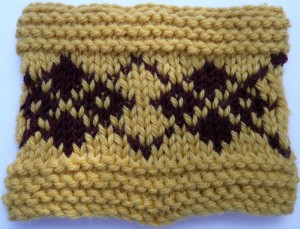
Very cool! Experiments are to make one think, and even if they don’t always turn out as originally envisioned, the thinking is the most important part of the process. It’s fun to see you think! 🙂
You can also achieve some interesting, experiment-worthy results in the same vein as your wool/cotton swatch using a combo of 100% wool and superwash wool or blend yarns of the same weight, then washing the swatch deliberately trying to shrink the vulnerable wool. If the chosen design’s field is non-shrink superwash, criss crossed by diagonals of single stitch shrinking wool you can end up with a texture that looks like puffy mushroom cap gathers.
Another fun play with stranding is to sometimes leave the strands on the right side of the work, using them as part of the overall patterning.
In any case, thank you for sharing your experiments (and making me think, too) -K.
That is very cool! I hadn’t quite clicked that i was doing fair isle whilst knitting my tea cozy!